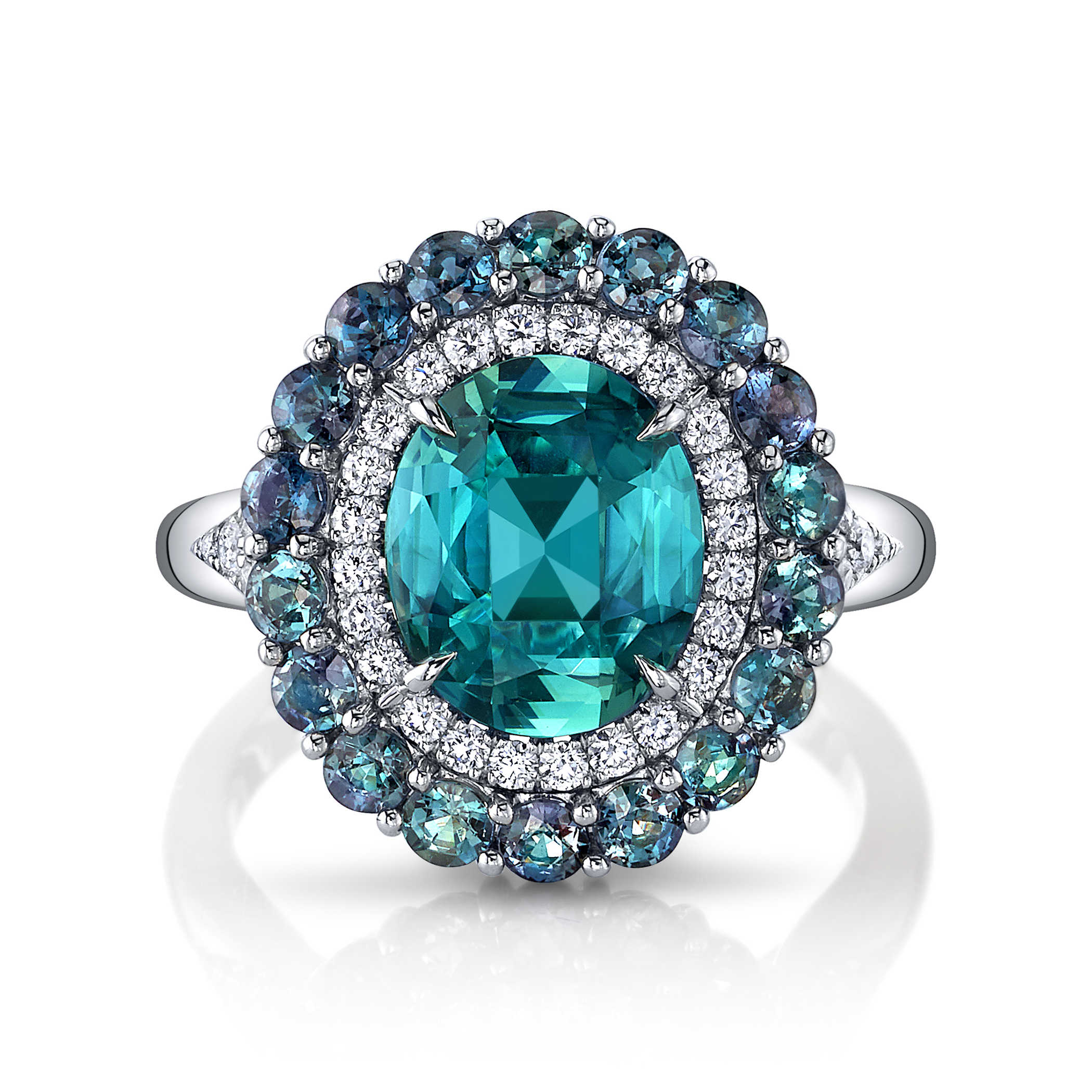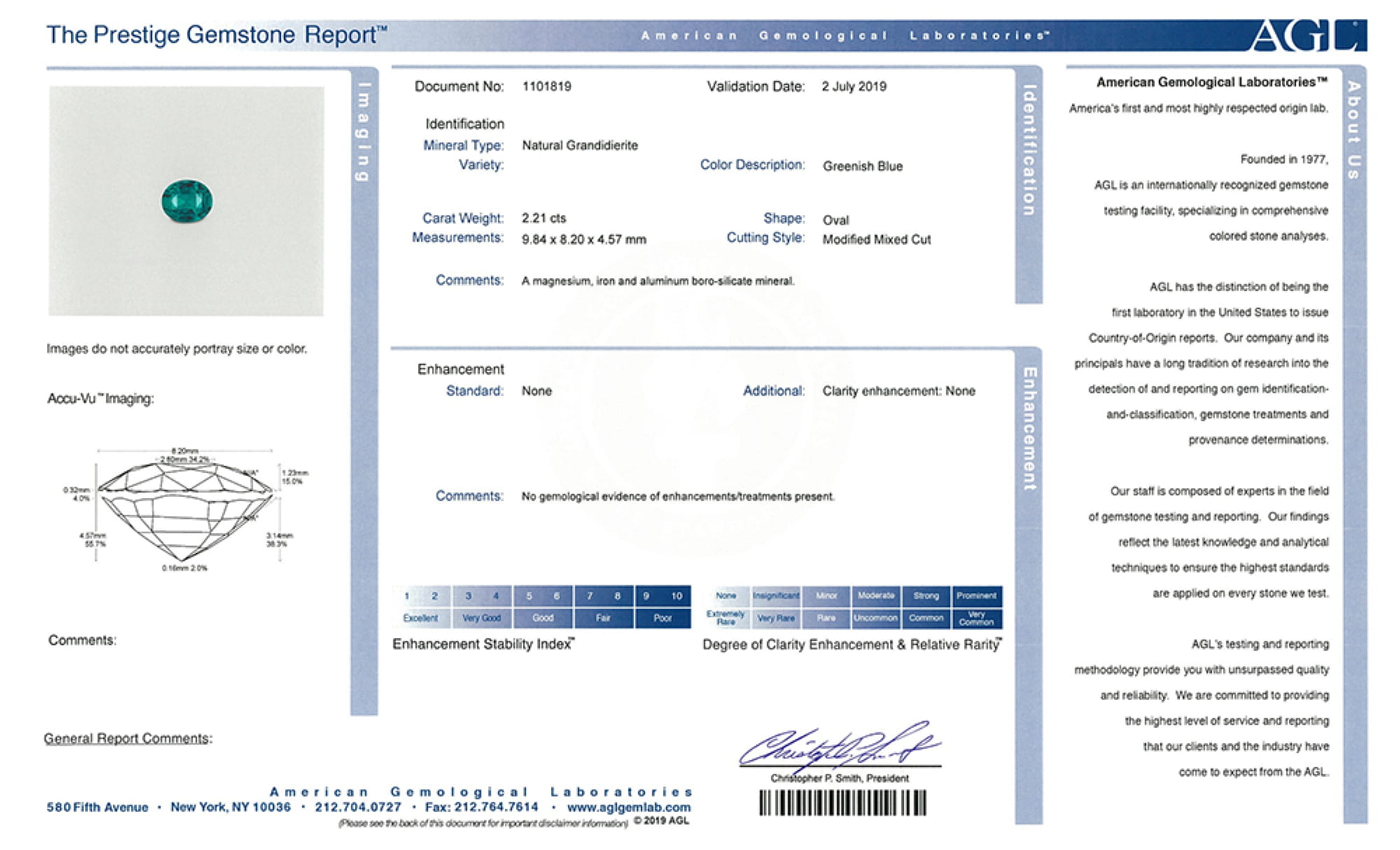




Grandidierite, Alexandrite & Diamond Ring
Platinum ring featuring a 2.21 carat oval grandidierite accented by 1.18 carat total weight of round alexandrites and 0.34 carat total weight of round diamonds.
R2404-RC1655-GROV
Design Details
Grandidierite, Alexandrite & Diamond Ring
Platinum, Size 6.5
1 Grandidierite Oval 2.21 ct. (9.84x8.20x4.57mm) - Natural
18 Alexandrite Rd 1.18 ctw. - Natural
44 Diamond Rd 0.34 ctw. (F+/VS+)
Unique Design Traits
Grandidierite is a true collector's stone, with many consumers unaware of its existence because so few faceted stones are available in the market.
Design combines two of the rarest gemstones on earth, both grandidierite and alexandrite are rarely found and faceted in sizes over one carat.
Both grandidierite and alexandrite are natural stones that rarely receive treatment of any kind. Typically, degree of color-change is considered the most important quality factor when judging alexandrites.
The halo displays nearly 100% color change. Winner of the 2020 AGTA Spectrum Awards - Bridal Wear, Honorable Mention
Gemstone Details
Grandidierite
Grandidierite is one of the rarest minerals on earth. It was first discovered in 1902 in southern Madagascar and named in honor of French explorer Alfred Grandidier (1836–1912) who studied the natural history of Madagascar. The original discovery of the stone was located in a small pegmatite outcrop in the cliffs of Andrahomana, which is on the southern coast of Madagascar.
Since its initial discovery, specimens of grandidierite have been found in select locations around the world, including Malawi, Namibia and Sri Lanka. In 2014, about 35 miles northwest of the original deposit find, in the Amboasary district of southern Madagascar’s Anosy region gem quality rough was discovered. With very few exceptions, the only location where gem quality material has been discovered is Southern Madagascar.
Most faceted stones have been under one carat in size with obvious inclusions; in very rare finds three to five carats or slightly larger have been produced. With two directions of cleavage, grandidierite is also very susceptible to damage and breaking during the cutting process, which adds to the value of large, high quality stones. It is strongly trichroic, but often cut so face up it has a blue to bluish green color.
Alexandrite
Alexandrite is one of the most unique and rare gemstones ever discovered. It is a phenomenal variety of the mineral chrysoberyl that naturally color changes from bluish green in daylight to purplish red in incandescent light. First discovered in 1830 in Czarist Russia in the Ural Mountains. Since the imperial colors of Russia were red and green, the newly discovered stone was named after Czar Alexander II, then heir to the throne. Quickly it became the national stone of Russia, worn by royalty and the nobility. Today, fine alexandrites, particularly those of Russian origin, are most often found in period jewelry since newly mined gems are extremely rare.
The original source in Russia’s Ural Mountains has long since closed after producing for only a few decades. In 1987 a new deposit of Alexandrite was found in Hematita, Brazil. Although there are other areas where Alexandrite has been discovered, Brazil is considered the finest source for Alexandrite since the 19th century. The most important quality factor when determining the value of an Alexandrite is its color change, caused by the complex way this mineral absorbs light. All other things being equal; the more dramatic the color change, the higher the value. Fine quality stones over one carat are exceptionally rare.
Alexandrite is the birthstone for June and the gem for the 55th wedding anniversary.


